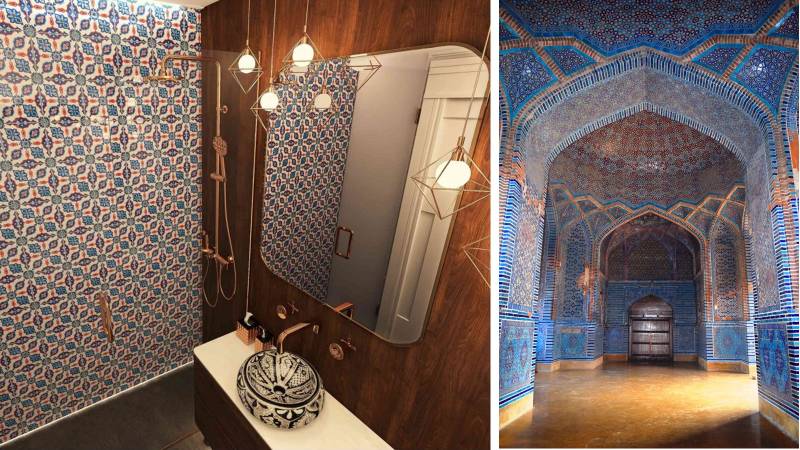
The town of Hala, located on the banks of the Indus River, has been a centre of arts and crafts for centuries. The history of tile making in Hala can be traced back to the Mughal era, when the art of glazed tile work, also known as kashi, flourished under royal patronage. The Mughals, renowned for their architectural splendour, introduced Persian techniques of tile making to the Indian subcontinent. Hala tiles, influenced by these Persian styles, evolved into a distinct form characterised by local motifs and vibrant colours.
The process of creating Hala tiles is labour-intensive and involves several meticulous steps, all carried out by skilled artisans who have inherited their craft through generations.
The journey of a Hala tile begins with the selection of high-quality clay. The clay is kneaded and left to rest to achieve the desired consistency. This step is crucial as it ensures the durability and smoothness of the tiles.
The prepared clay is then shaped into tiles using moulds. These moulds define the size and basic shape of the tiles. Once shaped, the tiles are left to dry in the sun. This drying process, which can take several days, is essential to prevent cracking during firing.
After drying, the tiles are coated with a white glaze, which serves as the canvas for the intricate designs. Artisans use natural pigments to paint intricate patterns, often inspired by floral motifs, geometric shapes, and traditional Sindhi designs. The use of cobalt blue, turquoise, green, and yellow is particularly distinctive in Hala tiles, giving them their characteristic vibrancy.
The painted tiles are then fired in a kiln at high temperatures. This process not only hardens the tiles but also fuses the glaze and pigments, ensuring the longevity of the colours and designs. The firing process is critical and requires precise control of temperature to achieve the perfect finish.
The availability of high-quality clay, competition from mass-produced tiles, and the need for skilled labour are significant concerns
Hala tiles are more than just decorative items; they are a significant part of the cultural and architectural heritage of Sindh. Historically, these tiles have been used to adorn mosques, shrines, and palaces, reflecting the region's artistic and religious traditions.
The use of Hala tiles in architecture is most prominently seen in the Shah Jahan Mosque in Thatta, a UNESCO World Heritage site. The mosque, built in the 17th century, is renowned for its exquisite tile work, which covers the walls, domes, and minarets. The intricate patterns and vibrant colours of Hala tiles create a mesmerising visual effect, showcasing the skill and creativity of the artisans.
In addition to their architectural significance, Hala tiles also carry religious and social symbolism. The patterns often include verses from the Quran, floral motifs representing paradise, and geometric designs symbolising the infinite nature of the universe. These elements not only enhance the aesthetic appeal of the tiles but also imbue them with spiritual meaning.
The art of Hala tile making has been preserved through generations, with artisans passing down their knowledge and skills to their descendants. This transmission of tradition ensures that the unique techniques and designs continue to thrive, despite the challenges posed by modernisation and changing market dynamics.
In recent years, there has been a resurgence of interest in traditional crafts, including Hala tiles. This renewed appreciation is driven by a growing awareness of cultural heritage and a desire to support sustainable, handmade products.
Efforts to revive the craft of Hala tile making have been supported by various organisations and government initiatives. Workshops, exhibitions, and training programs aim to provide artisans with the skills and resources needed to sustain their craft. These initiatives also seek to connect artisans with contemporary markets, creating opportunities for economic empowerment.
While traditional Hala tiles continue to be used in religious and cultural sites, they have also found new applications in modern interiors and architecture. Designers and architects are incorporating Hala tiles into contemporary homes, restaurants, and public spaces, blending traditional craftsmanship with modern aesthetics. The tiles are used for flooring, wall cladding, and decorative panels, adding a touch of heritage and elegance to modern designs.
Despite the growing interest, the craft of Hala tile making faces several challenges. The availability of high-quality clay, competition from mass-produced tiles, and the need for skilled labour are significant concerns. However, these challenges also present opportunities for innovation and adaptation. By embracing modern technologies and marketing strategies, artisans can expand their reach and ensure the sustainability of their craft.

